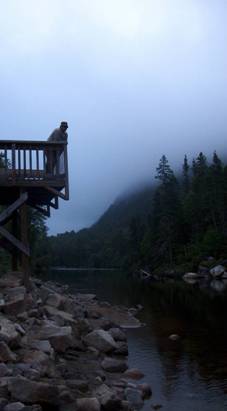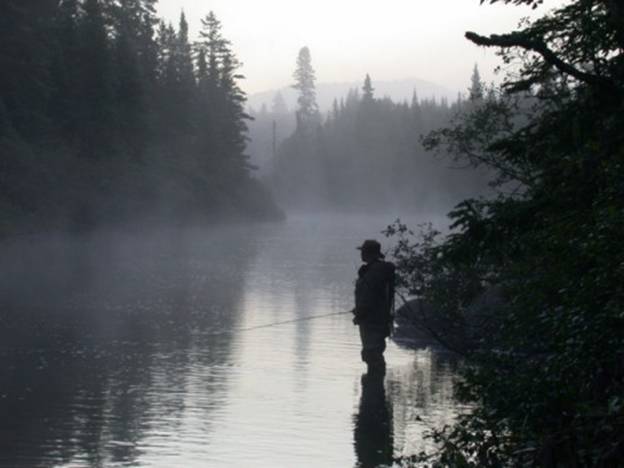FIRST LIGHT
| Sysadmin Note |
|---|
Part 1 of 2
|
I know I’ve said that one really doesn’t need to get up well before dawn on my home waters. Truth be told, I do frequently crawl out of my bunk in the wee hours of the morning. I don’t do this to be the first one on a run, nor because there is an over abundance of anglers here. In reality, I really like the early morning, always have, always will.
There’s just something special about dawn. I guess it could be the calm windless air, the mist shrouding the rapids or just the simple knowledge that you are the only one out and about.
This past season I was up for a week on the river. Liliane was in France for a month so I was going solo. Well, not truly alone as several friends were also camped out up and down the river.
I pulled in rather late into camp. Sure as sunrise, the wardens had lit a fire in the wood stove and there was a pile of dry birch in the corner of the camp. It is the third week of July, but the evening chill will still settle into the bedding. (I guess I’m just getting old!). I quickly dumped my gear under the awning of the prospector’s tent, setup an extra lantern then went about stringing up a trout rod as well as a salmon rod.
The forecast for tomorrow is for a clear and sunny morning and then a trough will move through dropping 20-35 mm of rain. The river is really low and clear so the leaders get re-vamped and lengthened well past 2x the length of the rods. The salmon rod ends up with a 22 foot leader ending in a 6lb tippet. The trout rod is rigged with a 26 foot leader and ends with a 3 lb tippet. I will prefer to get in a few hours in the early morning. Since I’ll be fishing before sunup, I tie on a big #10 rabbit strip Muddler for trout and a sparsely tied #10 Green Highlander for salmon. Not your standard fare for salmon fishing, but it has been a weird season with low water conditions ever since spring breakup.

During the 2010 season I have been running all over Eastern Canada for the day job, so I just naturally open my eyes around 4 a.m. This morning is no exception. It’s too early to fish, so a pot of coffee sets to perking while I take a short walk up to the #25 pool to see (hear) if any trout are out hunting for voles.
No such luck. I walk the 200 yards back to camp by the light of my head lamp. The aroma of freshly brewed coffee can be perceived 50 feet out. I load up a travel mug and grab the salmon rod to see how I can do over on the #23.
From the gallery over the #23 one has a perfect vantage point to try and spot salmon. (Right – Jack Crawford searching for salmon).
In the faint light I can see the distinct forms of salmon amongst the rocks. Not an easy task, but since I know where they should be holding, I can quickly make out several salmon and estimate their relative sizes.
Near the tail end of one group I can see there is a Grisle (juvenile salmon) holding back. I trot down to the edge of the river and strip out some line.
I know that there are other salmon in the pool, but since I know friends will be fishing here in a few hours, I leave the head of the run and target only the tail end of the pod holding the farthest down the run. I really only want to try for the Grisle anyway.
Ever since the remnants of Katrina rearranged the run a few years ago, the #23 pool here has become a classic run. We use a simple streamer swing here; down and across on a tight line.
I strip of 40 feet of line from the spool and lay down the cast at 45 degrees. No stripping, no mending, no extra movement imparted to the fly from my end. The light tippet, small fly and gentle current is all that is needed to get the fly to swing and swim at a medium trot through the current back towards the near bank. Further, the salmon are holding in a perfect situation.
Once the cast lies down, it takes a few feet of swing for the line to settle in, create a slight “J” and start fishing properly. As the salmon are mid current, the fly is swinging nicely as it passes 10 feet up stream form them. I let the swing fish out, strip off another 4 feet of line and cast again. This is not good technique. I would usually strip off 12-18 inches of line at a time to thoroughly cover the run. In this case however, I am sight fishing.
On the second cast, the fly comes within 6 feet of the pod and the Grisle gives a quick look. A bit more speed is needed on the swing. To do this, I strip off another 3 feet of line, cast and send a downstream mend into the presentation.
The mend speeds up the swing considerable and the extra line makes the fly swing through the same arc as the previous cast. The added speed is all it takes. As the fly swings into the Grisle’s cone of vision, it can’t help itself. The urge to take the fly is there. He darts forward 4 feet, lunges, takes and turns!
In a boil the line is automatically going taught. I keep a 6 inch loop of line between my finger and the reel. As this loop gets taken out, I simply raise the rod tip to vertical. I have a light tippet, so I don’t strike with my stripping hand too.
As the salmon has taken the fly and turned LEFT away from me, I know that he is hooked in the right side of his mouth. As soon as he turns again to face into the current, I can pull on him as hard as I want, knowing that the line won’t be pulling across his mouth (and thus often pulling the hook out!).
I haven’t kept a salmon in years and a Grisle is no exception so the fight is short (but exciting). He leaps several times and I bow to him each time (lowering the rod tip to not break the tippet). Within 10 minutes he is at my feet in the shallow water. I’m alone, so I don’t waste time trying to get a photo. A quick flick of the fly and the barbless hook easily slides out of the corner of his jaw. At 5:30 in the morning, it wouldn’t make a good photo anyway.
I inspect the fly to make sure it is still in good shape. Liliane makes most of my classic feather wings so the quality is impeccable. Still good to go! I spool up and head back to camp. I want to go check out a trout pool next before Dany wakes up and I haven’t even finished my coffee yet!

Looking for rises on the #3 – Photo: Marianne Corteau
| Sysadmin Note |
|---|
|
This is Part 1 of 2 |